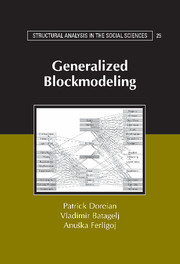Book contents
- Frontmatter
- Contents
- Preface
- 1 Social Networks and Blockmodels
- 2 Network Data Sets
- 3 Mathematical Prelude
- 4 Relations and Graphs for Network Analysis
- 5 Clustering Approaches
- 6 Optimizational Approach to Conventional Blockmodeling
- 7 Foundations for Generalized Blockmodeling
- 8 Blockmodeling Two-Mode Network Data
- 9 Semirings and Lattices
- 10 Balance Theory and Blockmodeling Signed Networks
- 11 Symmetric–Acyclic Blockmodels
- 12 Extending Generalized Blockmodeling
- Bibliography
- Author Index
- Subject Index
- Titles in the series
7 - Foundations for Generalized Blockmodeling
Published online by Cambridge University Press: 13 January 2010
- Frontmatter
- Contents
- Preface
- 1 Social Networks and Blockmodels
- 2 Network Data Sets
- 3 Mathematical Prelude
- 4 Relations and Graphs for Network Analysis
- 5 Clustering Approaches
- 6 Optimizational Approach to Conventional Blockmodeling
- 7 Foundations for Generalized Blockmodeling
- 8 Blockmodeling Two-Mode Network Data
- 9 Semirings and Lattices
- 10 Balance Theory and Blockmodeling Signed Networks
- 11 Symmetric–Acyclic Blockmodels
- 12 Extending Generalized Blockmodeling
- Bibliography
- Author Index
- Subject Index
- Titles in the series
Summary
In Section 6.1 we stayed within the framework of conventional blockmodeling and showed that structural and regular equivalences induce three special types of blocks: null blocks, complete blocks, and regular (one covered for both rows and columns) blocks. We also noted that different definitions of equivalence can lead to different identified blockmodels. In Section 6.2 we turned our attention toward generalizing blockmodeling by replacing indirect methods with direct methods and using optimization methods to delineate blockmodels and fit them to data. The next step, taken here, in our generalizing process is to expand the permitted types of ideal blocks. In doing this, we note, as we did in Section 4.3, that a partition determines an equivalence relation and vice versa. So, rather than specify new types of equivalences and derive their permitted block types, we simply expand the block types, knowing that partitions in terms of these new block types will determine new equivalences.
By proceeding in this fashion, we are making a subtle change in thinking about equivalences that signals, and emphasizes, a complete break with the indirect approach to establishing blockmodels. By focusing on the block types alone, we dispense with the need to measure the extent to which pairs of units are equivalent. Such measures become irrelevant: We focus instead on identifying and fitting block types. This is done empirically within the direct approach outlined in the previous chapter.
Network analysts often have some theoretical knowledge concerning the structure of the clusterings of units and of the structure of ties between positions (e.g., core periphery, hierarchy). This kind of information can be used to constrain clusterings and to specify blockmodels in advance.
- Type
- Chapter
- Information
- Generalized Blockmodeling , pp. 210 - 246Publisher: Cambridge University PressPrint publication year: 2004
- 2
- Cited by



